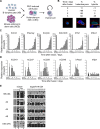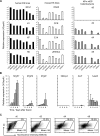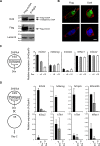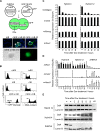Heterokaryon-based reprogramming of human B lymphocytes for pluripotency requires Oct4 but not Sox2
- PMID: 18773085
- PMCID: PMC2527997
- DOI: 10.1371/journal.pgen.1000170
Heterokaryon-based reprogramming of human B lymphocytes for pluripotency requires Oct4 but not Sox2
Abstract
Differentiated cells can be reprogrammed through the formation of heterokaryons and hybrid cells when fused with embryonic stem (ES) cells. Here, we provide evidence that conversion of human B-lymphocytes towards a multipotent state is initiated much more rapidly than previously thought, occurring in transient heterokaryons before nuclear fusion and cell division. Interestingly, reprogramming of human lymphocytes by mouse ES cells elicits the expression of a human ES-specific gene profile, in which markers of human ES cells are expressed (hSSEA4, hFGF receptors and ligands), but markers that are specific to mouse ES cells are not (e.g., Bmp4 and LIF receptor). Using genetically engineered mouse ES cells, we demonstrate that successful reprogramming of human lymphocytes is independent of Sox2, a factor thought to be required for induced pluripotent stem (iPS) cells. In contrast, there is a distinct requirement for Oct4 in the establishment but not the maintenance of the reprogrammed state. Experimental heterokaryons, therefore, offer a powerful approach to trace the contribution of individual factors to the reprogramming of human somatic cells towards a multipotent state.
Conflict of interest statement
The authors have declared that no competing interests exist.
Figures






Similar articles
-
Reprogramming of human somatic cells to pluripotency with defined factors.Nature. 2008 Jan 10;451(7175):141-6. doi: 10.1038/nature06534. Epub 2007 Dec 23. Nature. 2008. PMID: 18157115
-
Molecular coupling of Xist regulation and pluripotency.Science. 2008 Sep 19;321(5896):1693-5. doi: 10.1126/science.1160952. Science. 2008. PMID: 18802003
-
Gata4 blocks somatic cell reprogramming by directly repressing Nanog.Stem Cells. 2013 Jan;31(1):71-82. doi: 10.1002/stem.1272. Stem Cells. 2013. PMID: 23132827
-
Induced pluripotent stem cells: what lies beyond the paradigm shift.Exp Biol Med (Maywood). 2010 Feb;235(2):148-58. doi: 10.1258/ebm.2009.009267. Exp Biol Med (Maywood). 2010. PMID: 20404029 Free PMC article. Review.
-
The transcriptional foundation of pluripotency.Development. 2009 Jul;136(14):2311-22. doi: 10.1242/dev.024398. Development. 2009. PMID: 19542351 Free PMC article. Review.
Cited by
-
New Translational Trends in Personalized Medicine: Autologous Peripheral Blood Stem Cells and Plasma for COVID-19 Patient.J Pers Med. 2022 Jan 10;12(1):85. doi: 10.3390/jpm12010085. J Pers Med. 2022. PMID: 35055400 Free PMC article.
-
Half brain irradiation in a murine model of breast cancer brain metastasis: magnetic resonance imaging and histological assessments of dose-response.Radiat Oncol. 2018 Jun 1;13(1):104. doi: 10.1186/s13014-018-1028-8. Radiat Oncol. 2018. PMID: 29859114 Free PMC article.
-
REST selectively represses a subset of RE1-containing neuronal genes in mouse embryonic stem cells.Development. 2009 Mar;136(5):715-21. doi: 10.1242/dev.028548. Development. 2009. PMID: 19201947 Free PMC article.
-
CHD7 targets active gene enhancer elements to modulate ES cell-specific gene expression.PLoS Genet. 2010 Jul 15;6(7):e1001023. doi: 10.1371/journal.pgen.1001023. PLoS Genet. 2010. PMID: 20657823 Free PMC article.
-
DNA methylation in stem cell renewal and multipotency.Stem Cell Res Ther. 2011 Oct 31;2(5):42. doi: 10.1186/scrt83. Stem Cell Res Ther. 2011. PMID: 22041459 Free PMC article. Review.
References
-
- Hochedlinger K, Jaenisch R. Monoclonal mice generated by nuclear transfer from mature B and T donor cells. Nature. 2002;415:1035–1038. - PubMed
-
- Wilmut I, Schnieke AE, McWhir J, Kind AJ, Campbell KH. Viable offspring derived from fetal and adult mammalian cells. Nature. 1997;385:810–813. - PubMed
-
- Gurdon JB. Adult frogs derived from the nuclei of single somatic cells. Dev Biol. 1962;4:256–273. - PubMed
-
- Byrne JA, Pedersen DA, Clepper LL, Nelson M, Sanger WG, et al. Producing primate embryonic stem cells by somatic cell nuclear transfer. Nature. 2007;450:497–502. - PubMed
-
- Davis RL, Weintraub H, Lassar AB. Expression of a single transfected cDNA converts fibroblasts to myoblasts. Cell. 1987;51:987–1000. - PubMed
Publication types
MeSH terms
Substances
Grants and funding
LinkOut - more resources
Full Text Sources
Other Literature Sources
Research Materials

